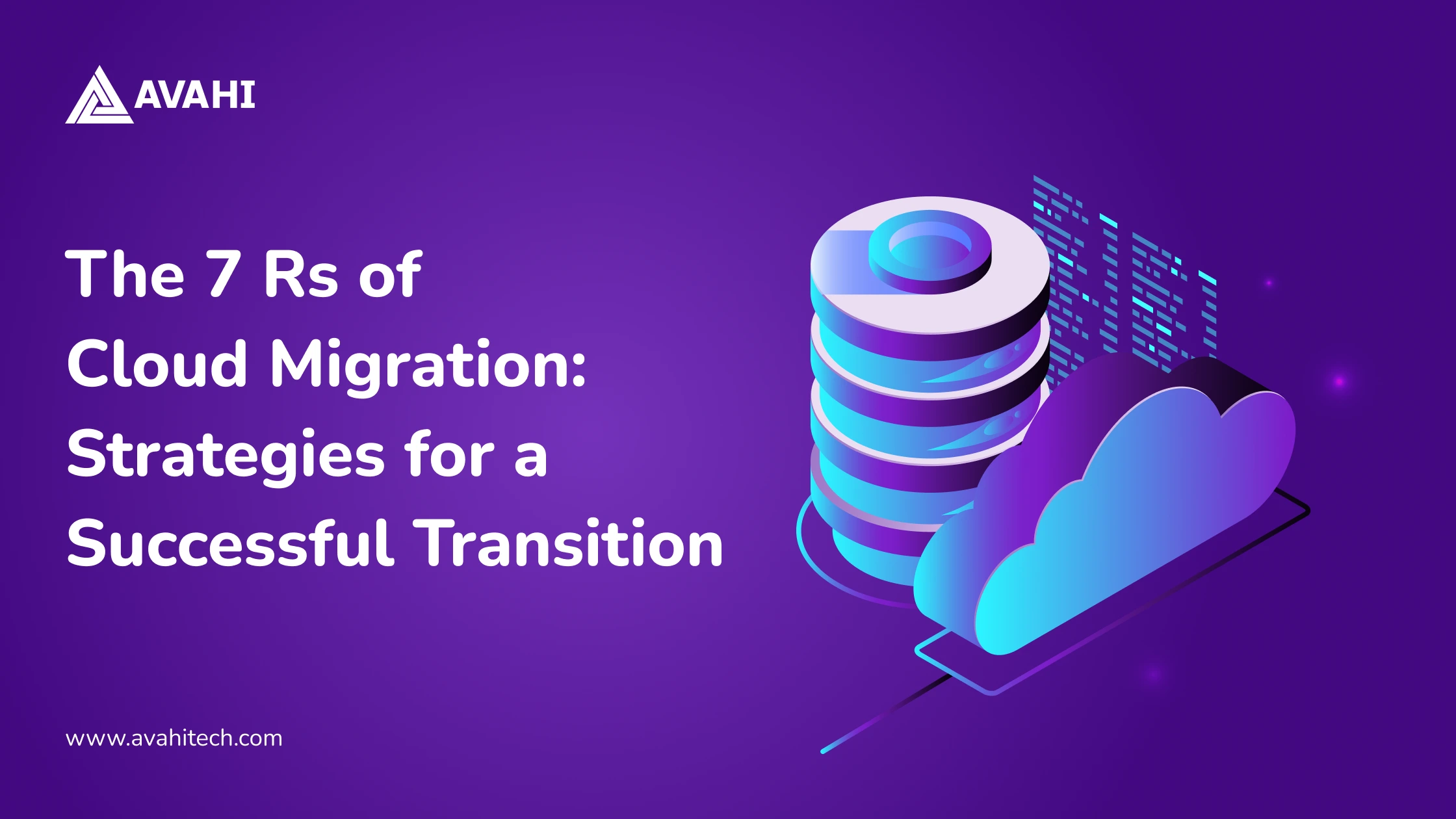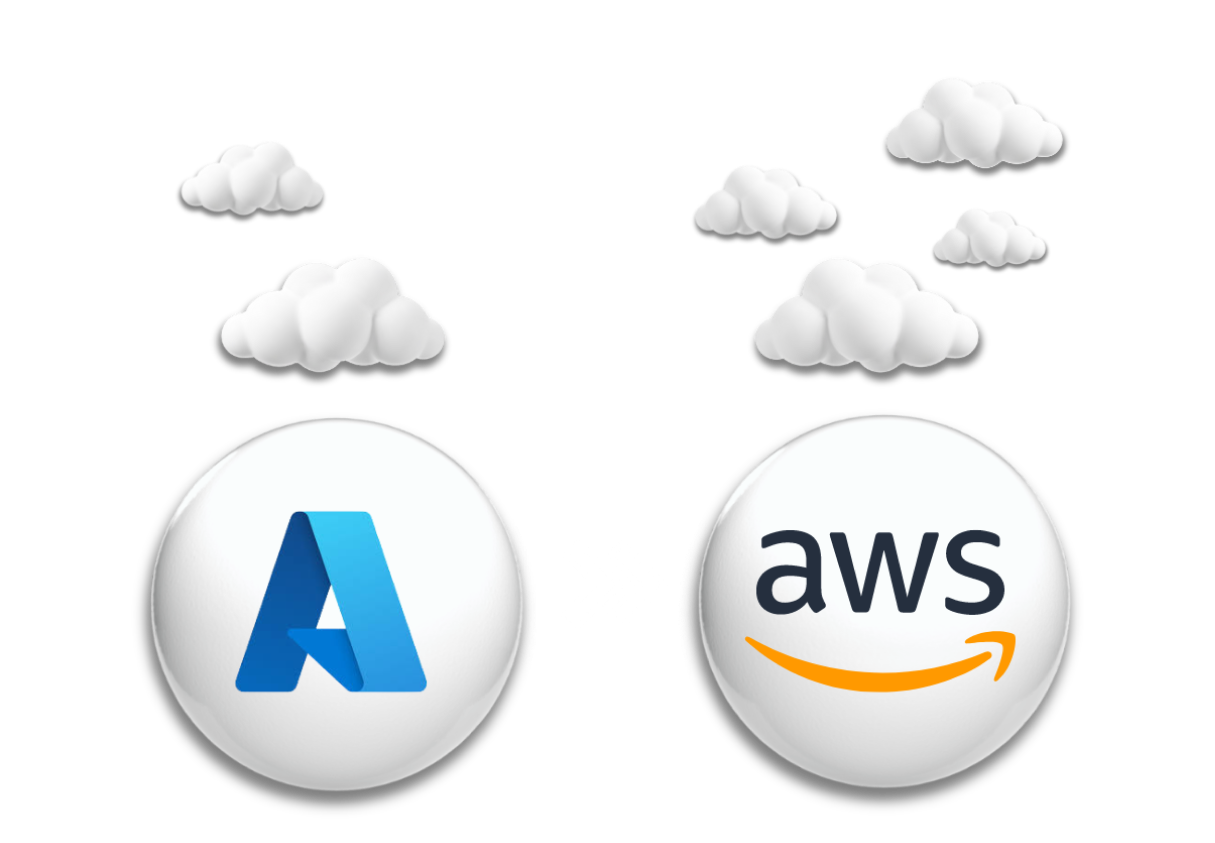According to a study, by 2025, 85% of organizations will achieve a 35% increase in sustainable efficiencies through software and cloud-based infrastructures. These statistics emphasize the growing importance of cloud migration strategies as businesses strive to enhance scalability, flexibility, and operational efficiency.
A cloud migration strategy involves carefully planning and executing the transfer of digital assets, services, and applications from on-premise infrastructures to cloud environments. This move enhances scalability and flexibility and optimizes costs and operational efficiency.
Understanding the 7 Rs—Rehost, Replatform, Refactor, Retain, Retire, Repurchase, and Relocate—is crucial for effective cloud migration. The 7 Rs of cloud migration represent strategies that help businesses move their IT systems to the cloud, each suited to different needs and goals. Below is a detailed explanation of each cloud migration strategy, providing insights into how businesses can effectively transition their IT systems to the cloud.
The Evolution of Cloud Migration Strategies
The evolution of cloud migration strategies began with Gartner’s introduction of the 5 Rs model, which helped organizations strategize their initial transitions to the cloud. As cloud technology matured, AWS expanded this to the 6 Rs by adding Retire to emphasize decommissioning outdated systems.
Further evolution led to the 7 Rs model, which included Retain to acknowledge that some workloads are best kept on-premises. This model offers organizations a more aligned approach to cloud migration, balancing modernization with regulatory and operational needs.
The 7 Rs of Cloud Migration Strategies
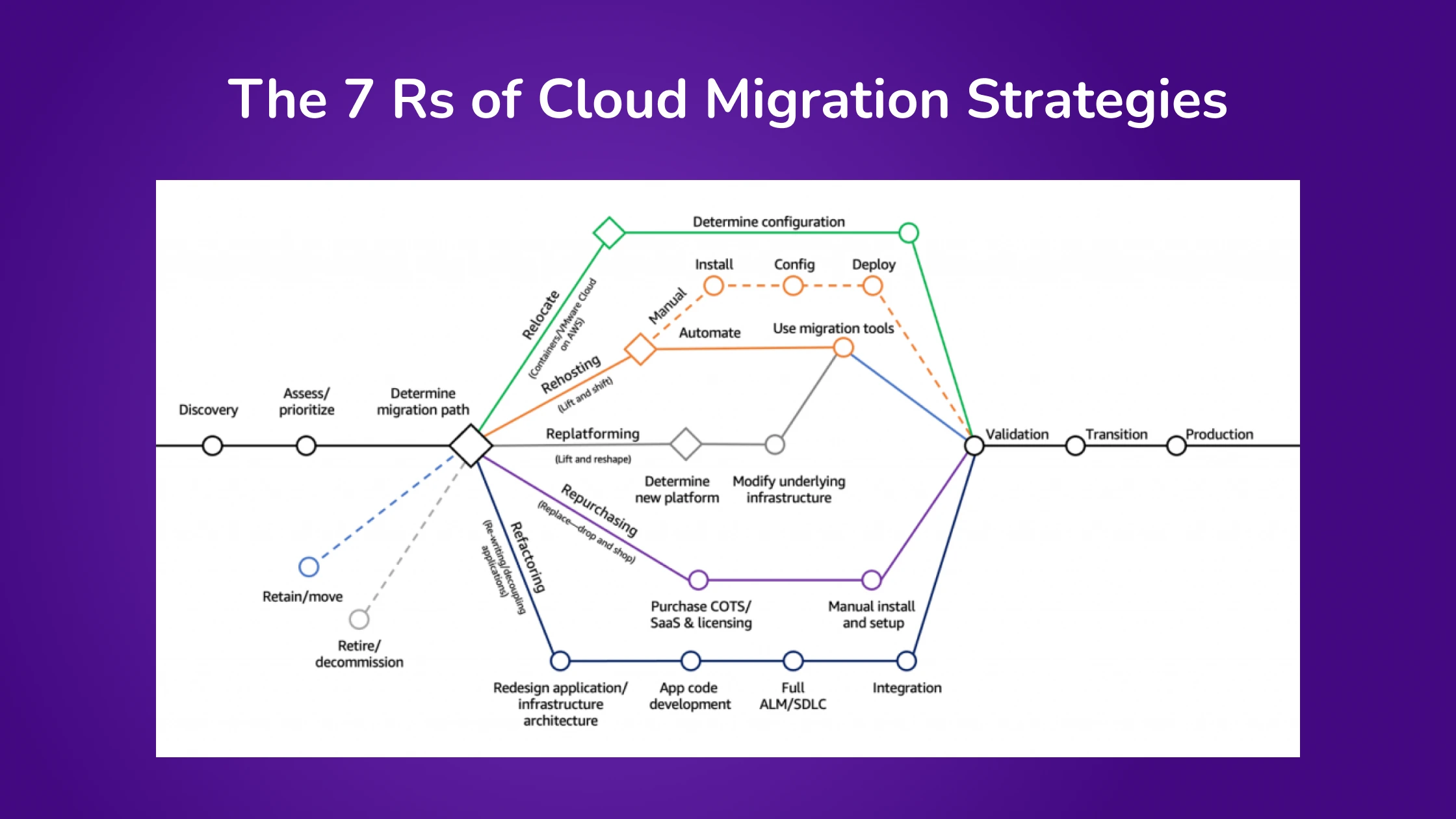
Source: AWS
Here is a detailed explanation of each of the strategies:
1. Rehosting
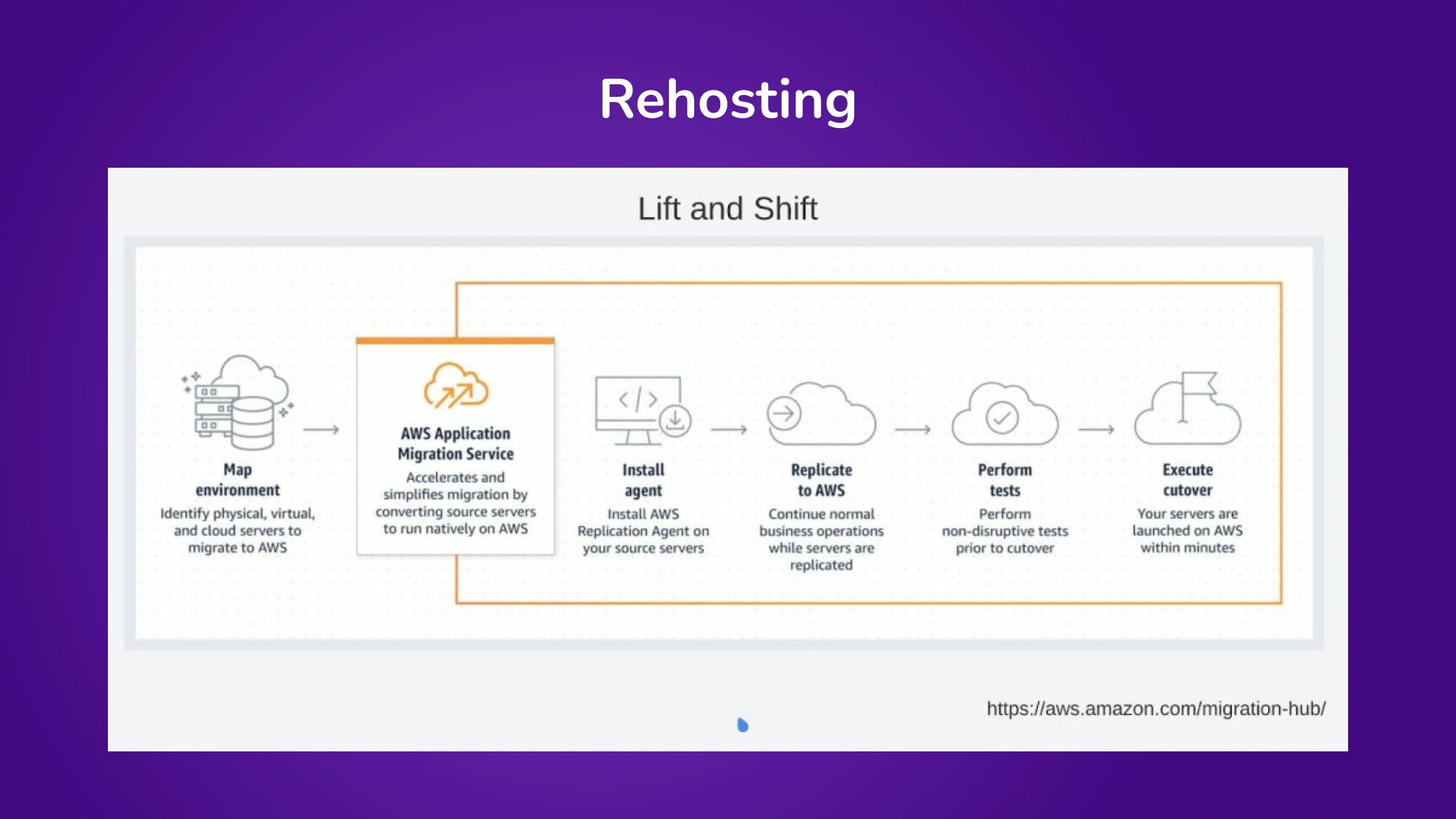
Rehosting, commonly known as “Lift and Shift,” is a cloud migration strategy that involves moving applications and their dependencies from an on-premise environment to the cloud without altering the underlying architecture. This strategy leverages Infrastructure-as-a-Service (IaaS) to redeploy workloads directly onto a cloud instance.
Implementing the rehost strategy involves selecting applications that require no modifications and using cloud services like AWS’s Server Migration Service and Migration Hub. These tools help replicate existing servers or virtual machines to the cloud, ensuring the applications operate just as they did on-premises but in a new cloud environment.
Example
A typical example is a company migrating its legacy CRM system using AWS Server Migration Service. The service replicates the company’s on-premise servers to the cloud with minimal downtime, allowing the CRM to function without changing its original setup or code.
Pros and Cons
| Pros | Cons |
| Quick Migration – Faster to implement as it requires no changes to the application’s code or architecture. | Limited Optimization – Does not take full advantage of cloud-native features, potentially leading to underutilization of cloud capabilities. |
| Reduced Complexity – Simplifies the migration process, ideal for companies without cloud-native expertise | Cost Inefficiency – May result in higher operational costs due to over-provisioning and the maintenance of legacy systems. |
| Lower Risk – Maintains the operational and configuration constructs of the workload, reducing the risk of errors | Scalability Issues – May encounter scalability limitations as the original infrastructure might not be designed for cloud scalability. |
| Immediate Continuity – Ensures business continuity by minimizing downtime during the migration process. | Future Rearchitecting Needs – Applications might need rearchitecting later to better align with cloud capabilities, adding to future costs. |
2. Relocate
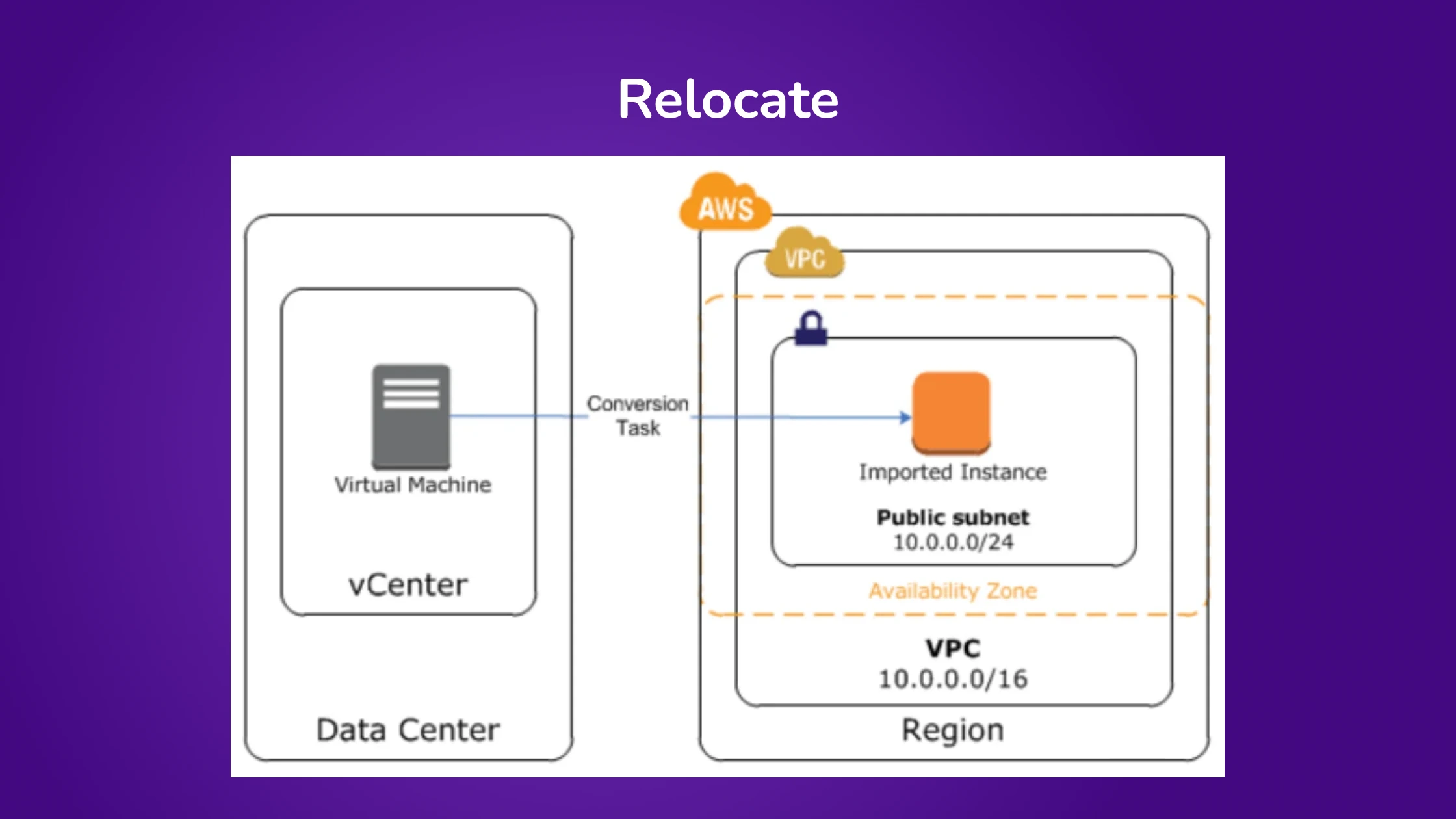
The Relocate strategy, or Hypervisor-Level Lift and Shift, involves transferring virtualized infrastructure from an on-premises environment to the cloud without altering the underlying architecture or the virtualization layer. This method allows businesses to move their existing virtual servers, such as those running on Kubernetes or VMware, directly to a similar cloud-based platform like Google Kubernetes Engine (GKE) or Amazon Elastic Kubernetes Service (EKS).
Implementation of the Relocate strategy involves using tools to transfer virtual machines (VMs) from on-premises hypervisors to cloud services. These tools, such as AWS VM Import/Export, facilitate the migration by replicating the entire virtualized environment to cloud instances, ensuring compatibility and minimal disruption.
Example
An enterprise using VMware vSphere for its local servers could employ the VMware Cloud on AWS service to relocate its virtualized servers. This process would transfer all server data and configurations directly to AWS without requiring new hardware purchases or major application rewrites.
Pros and Cons
| Pros | Cons |
| Minimal Downtime – Ensures continuous operations during migration, keeping systems online and accessible. | Limited Optimization – Does not fully exploit cloud-native features, potentially missing out on efficiency gains. |
| Cost Predictability – Migration expenses are more foreseeable due to the direct transfer of existing setups. | Scalability Constraints – May face limitations in scaling operations due to the original infrastructure design. |
| No Need for Retraining – Staff training requirements are minimal since the system architecture remains unchanged. | Future Re-architecting – This may require eventual re-architecting to utilize cloud capabilities better, adding to long-term costs. |
| Operational Continuity – Maintains existing licenses and setups, reducing the complexity of the migration process. | Initial Setup Complexity – Requires careful planning and execution to ensure compatibility between cloud and on-premises environments. |
3. Replatform
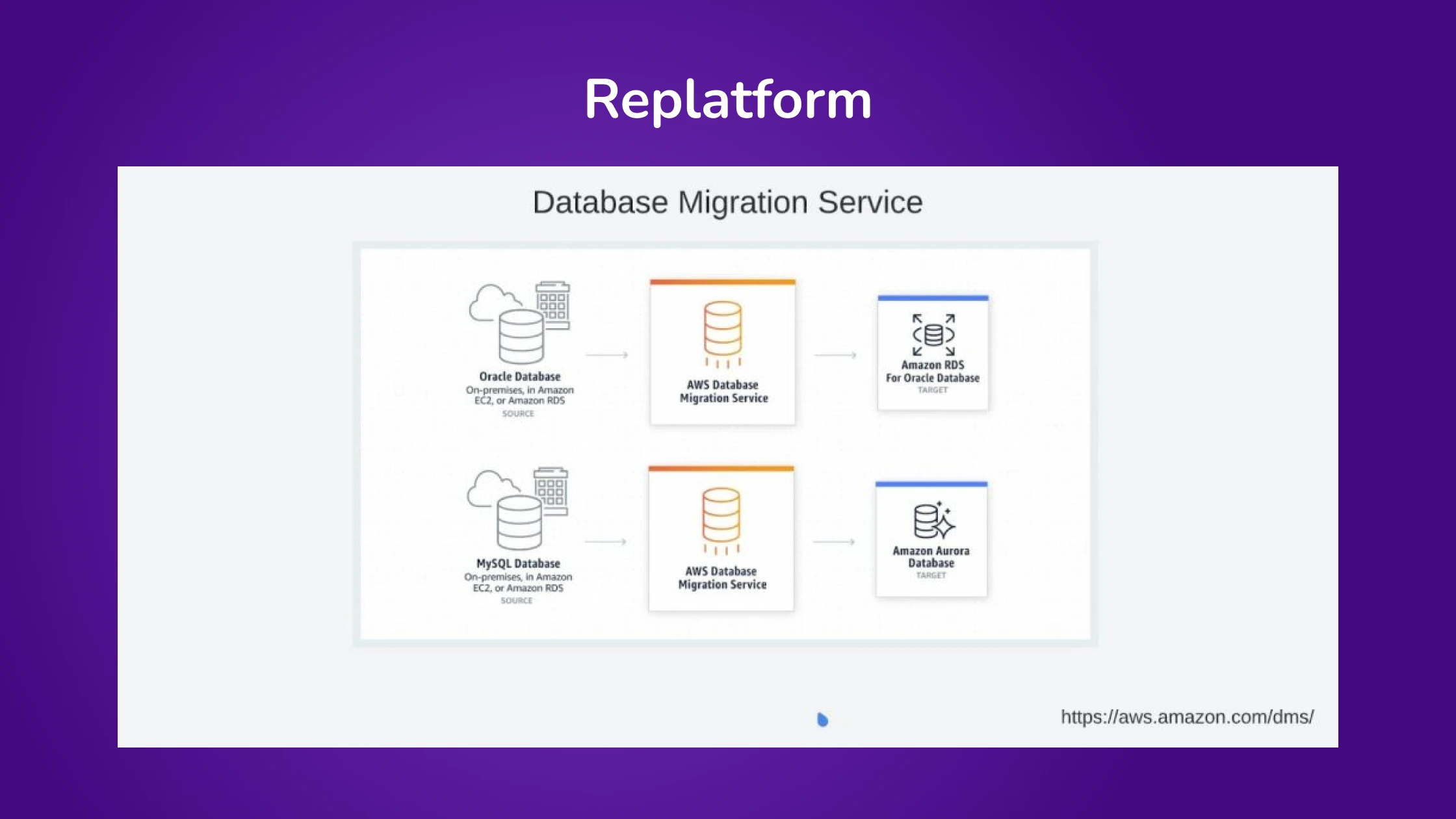
Replatforming, or “Lift, Tinker, and Shift,” or “Lift and Reshape,” involves moving applications to the cloud with selective modifications to optimize performance and leverage cloud-native features. The application’s core architecture and source code remain unchanged, ensuring the continuity of legacy operations while enabling enhanced agility, flexibility, and compliance with cloud-based security standards.
The platform strategy identifies specific areas within an application that can benefit from cloud optimizations, such as database management or scalability features. Tools like AWS Elastic Beanstalk for application deployment or Amazon RDS for database management effectively manage these components, allowing the organization to focus on application functionality rather than infrastructure management.
Example
An enterprise is moving its legacy customer database to the cloud using Amazon RDS. This allows the company to utilize AWS’s managed database services to enhance performance and security without rewriting the application’s core code.
| Pros | Cons |
| Enhanced Performance – Targeted cloud optimizations improve application performance and scalability. | Potential Compatibility Issues – Minor changes might lead to unexpected compatibility challenges that require further attention. |
| Cost Efficiency – Optimized cloud resource usage, potentially reducing overall operational costs. | Limited Cloud Benefits – May not fully leverage all cloud features, as the core architecture remains largely unchanged. |
| Minimal Disruption – Less intrusive compared to full-scale refactoring, facilitating smoother migration. | Moderate Investment – Requires investment in selective modifications, which could escalate if not managed carefully. |
| Strategic Modernization – Allows for incremental modernization of applications, aligning with business needs without extensive redevelopment. | Operational Complexity – Managing both legacy and new cloud components can increase the complexity of IT operations. |
4. Refactor
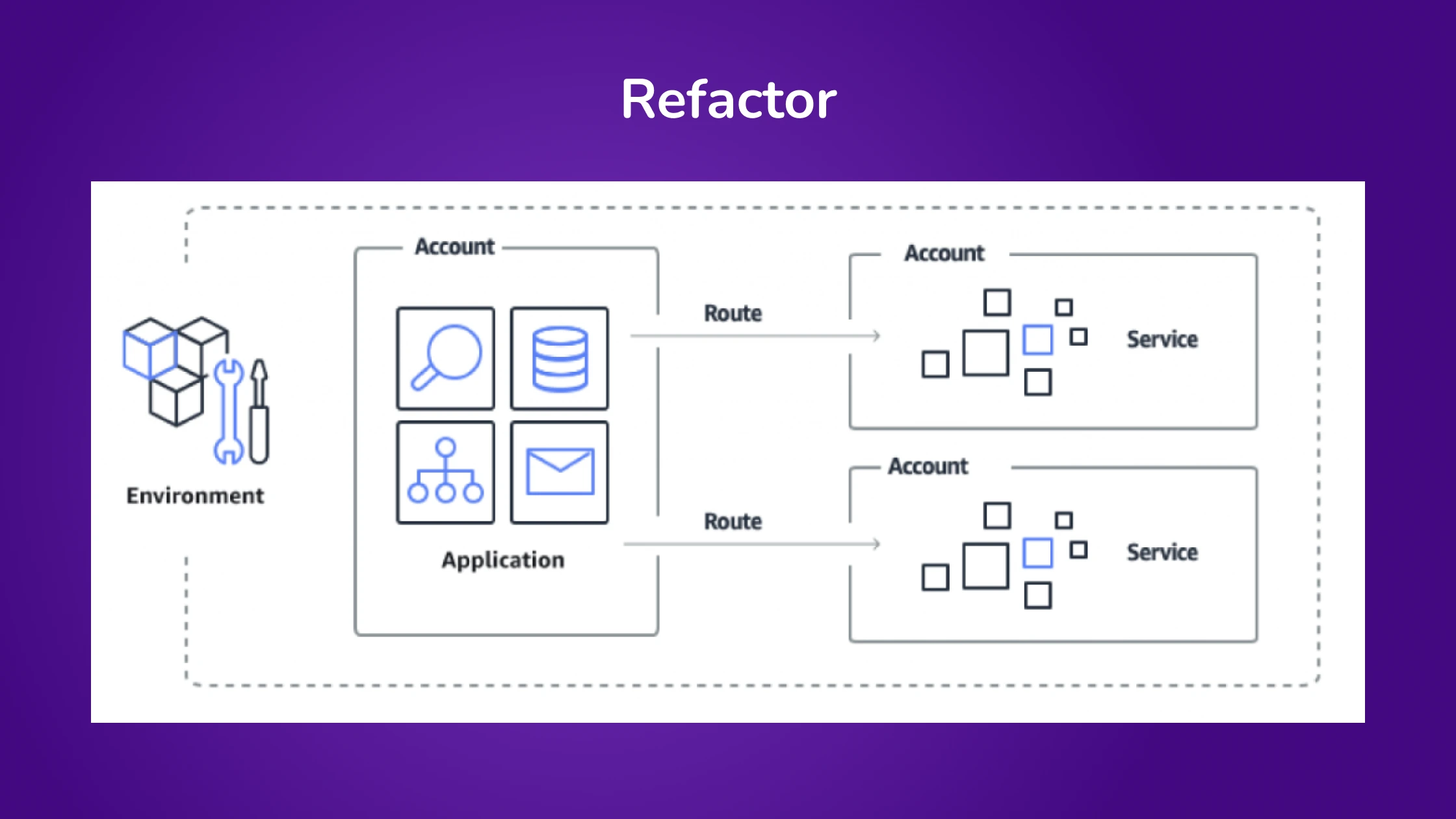
Source: AWS
Refactoring, or re-architecting, is a cloud migration strategy that involves redesigning applications to fully utilize cloud-native features like serverless computing, autoscaling, and distributed load balancing. This approach transforms a monolithic application into microservices, enhancing flexibility, scalability, and operational efficiency.
Implementing refactoring involves breaking down applications into smaller, independent components that can be developed, deployed, and managed autonomously. This process typically requires significant changes to the application’s code to ensure it effectively leverages the cloud environment, such as adopting managed services and utilizing cloud-specific APIs.
Example
A traditional e-commerce platform could be refactored into microservices, separating functions like inventory management, user profiles, and payment processing. Each service might utilize cloud capabilities such as AWS Lambda for serverless functions, ensuring scalability and reducing operational overhead.
Pros and Cons
| Pros | Cons |
| Enhanced Performance and Scalability – Cloud-native features improve application flexibility and user experience. | High Initial Costs – Significant investment is required to redesign and develop the application. |
| Future-Proof – Prepares applications for long-term evolution and compatibility with emerging technologies. | Complex Transition – Potential for operational disruptions and a steep learning curve during migration. |
| Operational Efficiency – Reduces resource wastage by leveraging autoscaling and other cloud-native capabilities. | Resource Intensive – Requires substantial developer time and expertise to implement changes. |
5. Repurchase
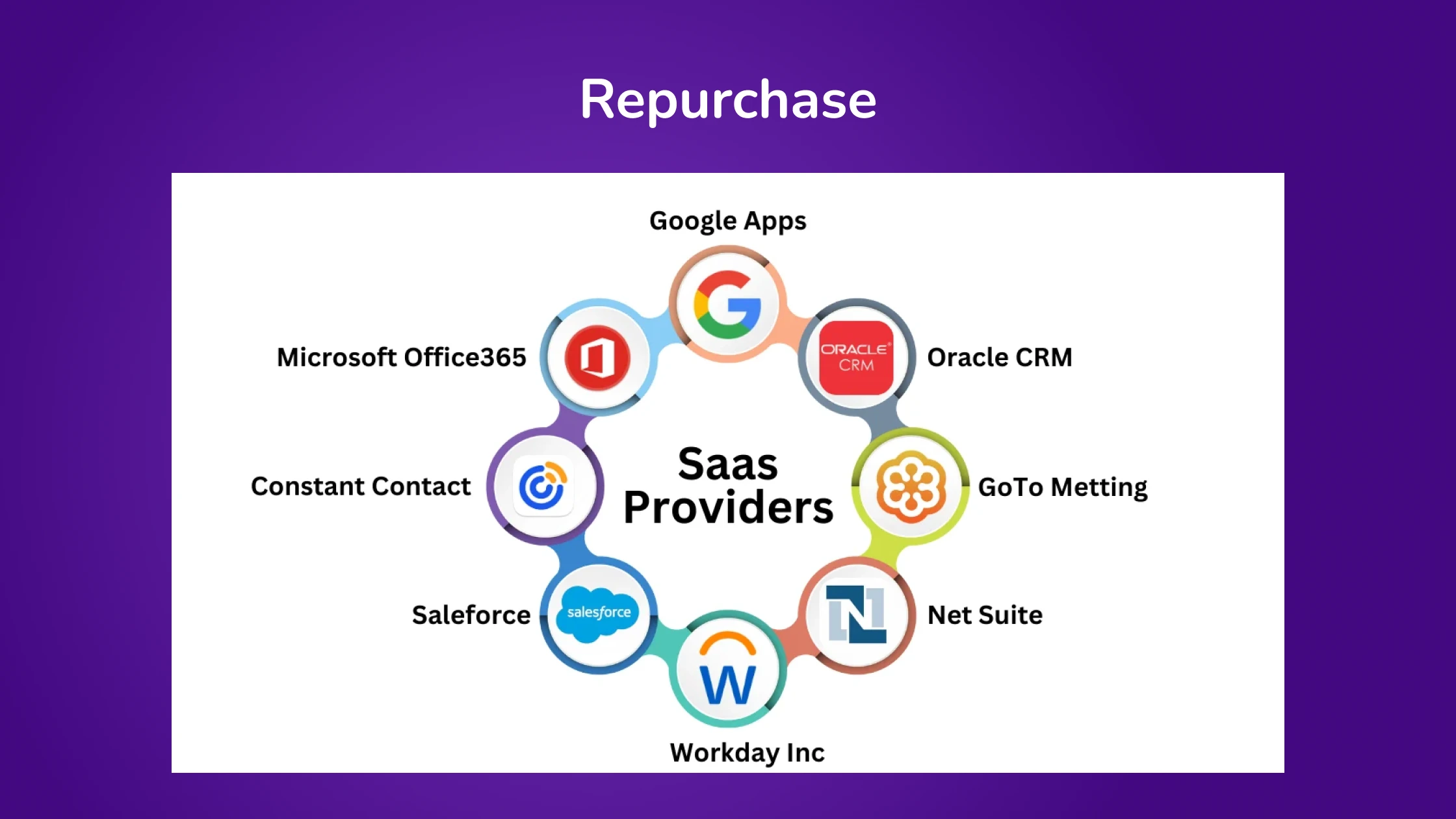
The repurchase strategy, often called “Drop and Shop,” involves replacing legacy systems with modern Software-as-a-Service (SaaS) solutions. This approach allows organizations to leverage the latest technology without the complexities of migrating old applications and data.
Implementation involves selecting a cloud provider that offers a SaaS solution that fits the business needs and transfers organizational data to this new platform. This strategy is generally quicker and involves less technical effort than other migration strategies.
Example:
An organization might switch from an on-premise CRM system to a cloud-based solution like Salesforce, enabling enhanced features, better scalability, and reduced maintenance without dealing with the legacy system’s limitations.
| Pros | Cons |
| Access to Modern Features – SaaS solutions offer updated capabilities that enhance business operations. | Loss of Customization – May lose specific features tailored in the legacy systems. |
| Reduced Maintenance – The SaaS provider handles updates and infrastructure, reducing IT workload. | Recurring Costs – Subscription fees can accumulate, potentially increasing long-term expenses. |
| Scalability – Easily scales with business growth, adjusting resources as needed without significant investment. | Workflow Adjustments – Adapting to a new system may require changes in existing business processes. |
6. Retire
The Retire strategy involves discontinuing the use of applications or systems that are no longer beneficial or pose a burden on resources. This eliminates outdated, redundant, or unsupported applications to streamline operations and reduce maintenance costs.
Implementation involves identifying applications that no longer serve a business purpose, are costly to maintain, or are not compliant with current security standards. These applications are then systematically decommissioned or archived, freeing up resources for more critical operations.
Example
An organization might identify an old customer relationship management (CRM) system replaced by a more efficient cloud-based solution. The old CRM is then fully decommissioned, with critical data archived and the remaining infrastructure shut down.
Pros and Cons
| Pros | Cons |
| Cost Reduction – Eliminates expenses related to maintaining outdated systems. | Risk of Data Loss – Potential loss of data if not properly archived. |
| Simplifies IT – Reduces complexity in the IT environment. | Dependency Issues – Possible impact on systems still linked to retired applications. |
| Enhances Security – Removes security vulnerabilities associated with outdated software. | Analysis Required – Needs thorough assessment to avoid impacting business operations. |
7. Retain
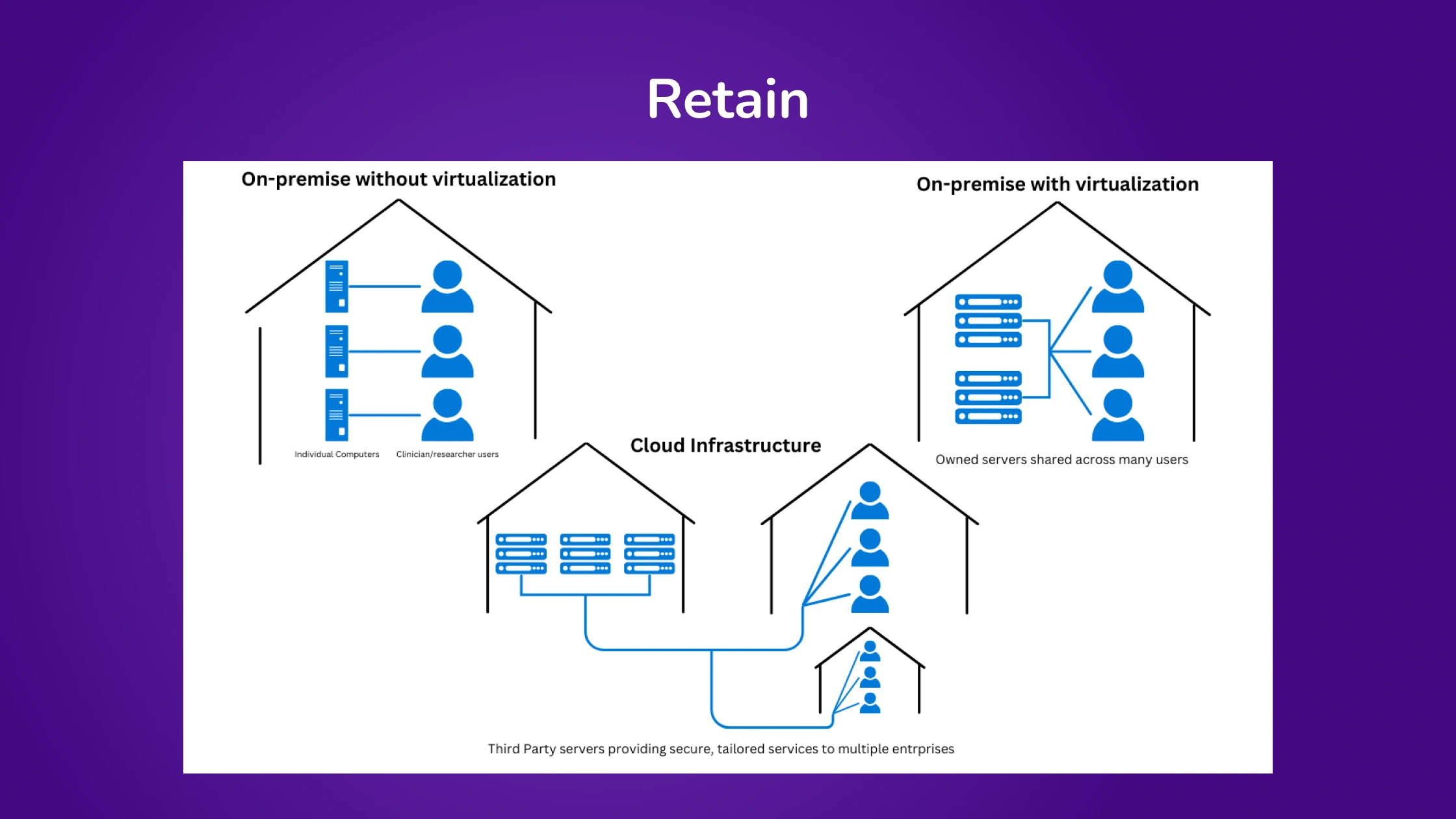
The Retain strategy is used for applications that must continue to operate in their current environment due to regulatory, technical, or business reasons. This approach involves keeping specific applications on-premise or in their existing cloud environment without migrating them to a new platform.
This strategy is implemented by assessing the applications’ compliance needs, performance requirements, and integration with other systems. Applications critical for operations that do not significantly benefit from cloud capabilities are maintained as-is.
Example
A financial institution may choose to retain its transaction processing system on-premise to comply with stringent financial regulations and to ensure ultra-low latency connections that might not be achievable with current cloud offerings.
Pros and Cons
| Pros | Cons |
| Compliance with Regulations – Meets stringent legal and regulatory requirements. | Limited Flexibility – May not take advantage of cloud scalability and innovation |
| Reduced Latency – Maintains performance by operating closer to the data source. | Higher Long-term Costs – Potentially more expensive due to continued maintenance of legacy systems |
| Controlled Environment – Keeps critical applications within a controlled, secure infrastructure | Slow Adaptation – Delays adoption of newer technologies which could hinder competitiveness. |
When to Use Each Cloud Migration Strategy
- Rehost: Use when you need a quick and straightforward migration with minimal changes to your existing applications.
- Replatform:Use when you want to optimize parts of your application for better performance without altering its core architecture.
- Refactor: Use when you aim to fully utilize cloud-native features by redesigning your application for maximum scalability and efficiency.
- Repurchase: Use when it’s more efficient to replace a legacy system with a cloud-based SaaS solution rather than migrate existing applications.
- Retire: This option is used when certain applications or systems are outdated, redundant, or no longer provide value, allowing you to decommission them.
- Retain: Use when you need to keep certain applications on-premise due to regulatory requirements, technical constraints, or lack of immediate business value in migrating.
- Relocate: Use when you need to move virtualized environments to the cloud without changing the underlying architecture or virtualization layer.
Experience Seamless Cloud Migration with Avahi’s AWS Experts!
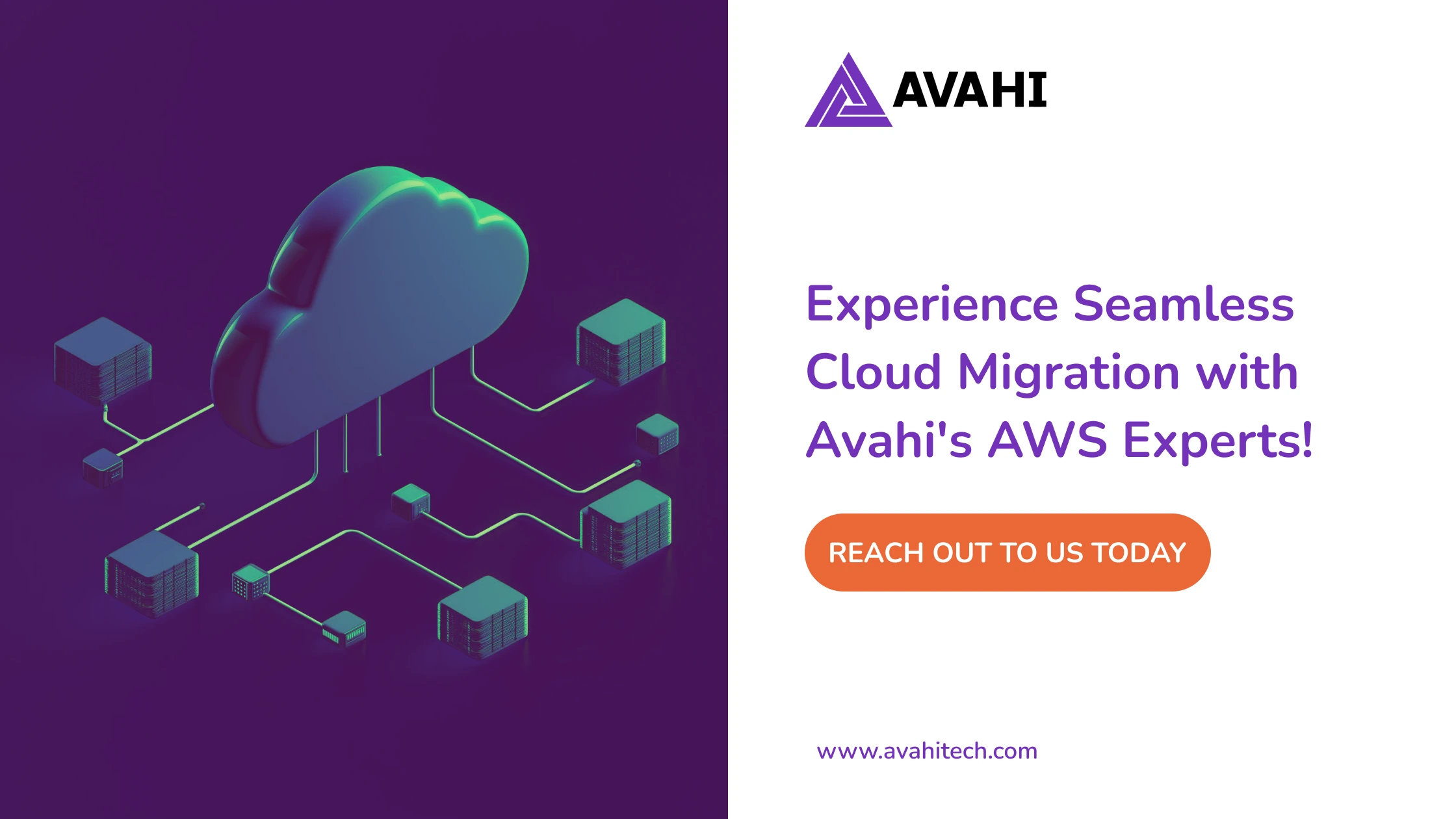
Transition to the cloud with confidence through Avahi’s specialized AWS Cloud Migration Consulting. Our expert team is equipped to handle the complexities of migrating applications and data from on-premise data centers to the cloud. Our services include:
With years of experience in enterprise customer migrations, we tailor our plans to meet your needs. Are you ready to transform your cloud strategy?
Schedule a Free Cloud Adoption Readiness Assessment.

